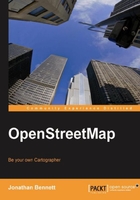
Unlike most sources of geographic data, there are virtually no restrictions on what you can do with OpenStreetMap data. You can use it for any purpose, including commercial activities, without having to pay license fees. You can edit the information in any way you like and publish the results. You can give the data to someone else without needing permission, and they can, in turn, pass it on. Your only obligation is to "share alike"; that is, to allow anyone you give OpenStreetMap data to redistribute it themselves. The particular license used is currently the Creative Commons Attribution Share-Alike 2.0 license, usually abbreviated as CC-BY-SA, although a process to change the license to the Open Database Licence 1.0 (ODBL) is currently being considered.
OpenStreetMap contains details of much more than just roads. All mappers are free to add any geographic object they find, so people have added phone boxes, bus stops, parks, public toilets, places of worship, and much more. Footpaths and cycleways are better represented in OpenStreetMap than many other databases, and there are already a number of cycling map and routing projects based on OpenStreetMap data.
OpenStreetMap is updated more often than any other geographic database. In fact, it's continually updated, and the latest data is always available to download. While proprietary databases may be updated frequently, those changes often aren't released to customers very quickly, leaving users with an out-of-date database for some time, possibly months. In contrast, the full OpenStreetMap database, known as the Planet file, is released every week, with updates ("diffs") released on a daily, hourly, and minute-by-minute schedule.
You can correct errors in OpenStreetMap data yourself, and share those corrections with everyone. In the UK, the problem of heavy goods vehicles using satellite navigation and being routed along narrow country lanes appears in the news regularly, and one man even found himself driving to the edge of a cliff by following his SatNav. Anyone encountering mistakes in the information like this can change the map themselves directly, and the changes show up in the database immediately.
Most of the other mapping providers only have maps in a limited number of styles, and obtaining custom maps can be an expensive and lengthy process. In contrast, with OpenStreetMap, the only limits to the number of mapping styles you can have is your own technical and cartographic ability. Several map rendering packages and Geographic Information Systems support OpenStreetMap data, and all the software you need to create maps is available free of charge..